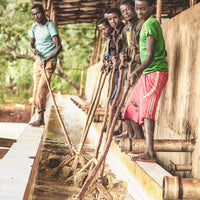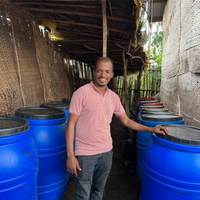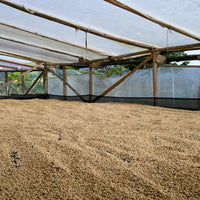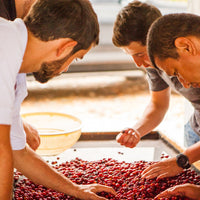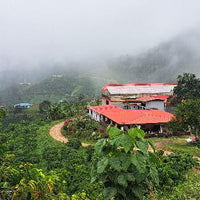Burundi Kibingo Cima Anaerobic Natural
Origin: Burundi
Region: Kayanza
Altitude: 1700 - 1900 meters above sea level
Farm: various community small-holders
Washing Station : Kibingo
Owner: Green Co
Variety: Red Bourbon
Process: Cima Anaerobic Natural
Tasting Notes: Clean, sweet, and very boozy with notes of green and pink lollies.
The Kibingo washing station is in the commune of Kayanza in northern Burundi. The station itself sits 1,893 meters above sea level. The altitude of the farms in the neighboring hills that supply the washing station varies from 1,700 to 1,900 meters above sea level.
Kibingo serves 3,515 registered coffee growers, spread over 18 hills in the area. All producers registered at a Greenco washing station are organized in groups of 30 people, headed by a farm leader. This leader acts as a spokesman to facilitate communication and organization with the washing station.
The washing station is equipped with 10 fermentation tanks, 2 soaking tanks and a drying field with 165 drying tables and 4 pre-drying tables. Kibingo can process 750,000 kg of cherry per day.
At the washing station, farmers can obtain organic fertilizer from composted coffee pulp. To promote farm renovation, producers can get low-cost, subsidized coffee seedlings at the washing station. Each station has its own nursery for this purpose.
Kibingo washing station participates in a number of farmer outreach and support projects include a goat and pig project, Farmer Hub, strengthening cooperatives and distributing fertilizer and coffee trees.
There are 3,515 smallholders living around Kayanza, Burundi who deliver their cherry to Kibingo washing station. In addition to operating 13 washing stations in Burundi and processing excellent coffee, Greenco is also working with communities to increase farmer livelihoods and general equality in coffee producing areas.
Most coffee trees in Burundi are Red Bourbon for reasons of quality. Because of the increasingly small size of coffee plantings, aging rootstock is a very big issue in Burundi. Many farmers have trees that are over 50 years old, but with small plots to farm, it is difficult to justify taking trees entirely out of production for the 3-4 years it will take new plantings to begin to yield. In order to encourage farmers to renovate their plantings, Greenco purchases seeds from the Institut des Sciences Agronomiques du Burundi (ISABU), establishes nurseries and sells the seedlings to farmers at or below cost.
Despite the ubiquity of coffee growing in Burundi, each smallholder producers a relatively small harvest. The average smallholder has approximately 250 trees, normally in their backyards. Each tree yields an average of 1.5 kilos of cherry so the average producer sells about 200-300 kilos of cherry annually.
The average cherry buying price for Greenco in 2019 was significantly above average. Washing stations make the first payment to farmers between 15-30 June. The second payment comes later in the summer. If the coffee wins a competition or sells for extremely high specialty prices, Greenco gives another payment approximately a year after the harvest season.
During the harvest season, all coffee is selectively hand-picked. Most families only have 200 to 250 trees, and harvesting is done almost entirely by the family. Greenco knows that even small distances can be time consuming and expensive to travel for smallholder farmers, and they know that receiving cherry immediately after harvest is crucial to quality. Therefore, smallholders can bring their cherries either directly to a washing station or to one of the 10-15 collection sites situated throughout growing areas. Farmers are paid the same for their quality cherry regardless of where they bring their cherries. In this way, farmers are not disadvantaged due to their location and Greenco bears the cost of transport to washing station’s.
Cherry is placed in airtight containers and Cima yeast purchased from the French company Lalcafe is added to the tanks. The tanks are then covered and left to ferment in this environment for approximately 36 hours.
LALCAFÉ CIMA™ yeast (Saccharomyces cerevisiae) was especially developed for coffee production over a four-year period of research and trials. Trials in various regions and environments showed that Cima is well suited to better control the wet process’ efficiency and to upgrade the cup quality. The yeast is able to control the fermentation process against the risk of spoilage micro-organisms that can generate undesirable defects. Furthermore, its specific metabolism and its high capacity of implantation even at cold temperatures (minimum 15°C inside the coffee tank) allows for the expression of fresh and fruity characteristics of the coffee beans while respecting the varietal original aromas of the beans. The longer fermentation time for yeast processed coffees also allows for more developed flavors. The extra time enables the beans to absorb metabolites, which can enhance flavors. Complexity, acidity, brightness, floral and high notes and more are all boosted by the lengthened fermentation time.
After fermentation, cherry is carried to the drying tables, where they will dry slowly for 2-3 weeks, during which time the cherry is repeatedly sorted and sifted to ensure even drying. Cherry is left to dry from sunrise to sunset and is covered with a sheet during the evening or when it rains. The moisture level is carefully monitored and any cherry with visual defects is removed.
Once dry, coffee is then bagged and taken to the warehouse. Greenco’s team of expert cuppers assess every lot (which are separated by station, day and quality) at the lab. The traceability of the station, day and quality is maintained throughout the entire process.
The average cherry buying price for Greenco in 2019 was significantly above average. CWSs make the first payment to farmers between 15-30 June. The second payment comes later in the summer. If the coffee wins a competition or sells for extremely high specialty prices, Greenco gives another payment approximately a year after the harvest season.
Before shipment, coffee is sent to Budeca, Burundi’s largest dry mill. The coffee is milled and then hand sorted by a team of hand-pickers who look closely at every single bean to ensure zero defects. It takes a team of two hand-pickers a full day to look over a single bag. UV lighting is also used on the beans and any beans that glows—usually an indication of a defect—is removed.
The mill produces an average of 300 containers of 320 bags per year. Budeca is located in Burundi’s new capital city, Gitega, with a population of around 30,000 people. Since there are approximately 3,000 people working at the mill, mostly as hand pickers, this means that Budeca employs nearly 10% of the total population in Gitega for at least half the year (during the milling season). The same is true in the provinces of Ngozi and Kayanza, where Greenco and Bugestal are the first employers in the region during the coffee harvest season. This has an incalculable impact on a country like Burundi, with unemployment rates above 50%, especially in rural areas and among young people.
Greenco, a company that oversees and structures washing stations in Kayanza province of Burundi, gives washing stations and producers support all along the production chain. They started their work in 2015, and have dominated all Cup of Excellence competitions in Burundi ever since. Currently, Greenco has 13 washing stations all located in Kayanza in the north of Burundi. The producers receive support from the Greenco CWS managers, who are all agronomic engineers. Greenco’s overall impact through these 13 central washing stations (CWS) extends to over 15,210 coffee producing households.
Greenco works with young agronomy graduates to provide farmer training and manage washing stations. Young graduates are particularly well suited for the work with Greenco because they can all work with computer systems, greatly simplifying the flow of information between the washing stations and Greenco. Also, they have a fresh and systematic approach to coffee production and processing, with up-to-date knowledge about farming practices. The agronomists received additional training from the NGO Kahawatu Foundation on best agricultural practices (BAP). Off season, they provide agronomy assistance to the roughly 15,210 farmers who deliver cherries to Greenco CWS to prepare for the next harvest.
Another socio-economic challenge that Greenco addresses is youth unemployment. The national youth unemployment rate is almost 50%. At Greenco, young graduates receive a decent salary and benefits (house, motorbike, healthcare) as well as real career prospects.
Next to improving quality and productivity, Greenco strives to improve socio-economic and environmental conditions around the washing stations. All of their washing stations have UTZ and 4C certification. One of their focus points is building an efficient supply chain around the CWS. Greenco is buying 93% of its cherries directly from farmers via collection centers. This way, they improve farm-gate price to the producers.
In addition to providing training on farming practices, Greenco organizes trainings for farmer groups about various social aspects. Coffee families learn about gender equality, financial planning, family planning and more.
Environmental stewardship is of paramount importance to Greenco. They have equipped all washing stations with water treatment facilities and solar panels and batteries. The station has ponds to purify the wastewater from processing before flowing back in the river network. The solar panels provide energy for computers, lighting and smartphones.
Burundi has long been overlooked in comparison to its neighboring East African specialty coffee producing powerhouses. However, Burundi season, for us, is one of the highlights of the annual coffee calendar. The country’s coffee is produced almost entirely by smallholder farmers, and much of this small-scale production is of exceptional quality. With its super sweet, clean and often floral coffees, Burundi, every year, is increasingly is putting itself on the specialty coffee map.
Coffee is of paramount importance to families and the country at large. Considering this, improving and expanding coffee infrastructure is not just a way to improve incomes, it is a way to revolutionize the earning potential of an entire nation.
Building washing stations and expanding agricultural extension work can be great ways to improve coffee quality. Washing stations are pivotal in improving cup profile standards and the global reputation of Burundian coffee.
Both state-owned and private actors drive Burundi’s coffee industry and play key roles as washing station management companies and exporters. State-owned companies are called Sogestals, short for “Sociétés de Gestions des Stations de Lavage” (Washing station management companies). Privately-owned companies can operate under a variety of different names.
Sucafina’s history in Burundi goes back to 2007 when Bucafe/Sucafina Burundi was established in Bujumbura. Through Bucafe, we work with several privately-owned washing station management companies and exporters. Our work bridges the entire supply chain, allowing us to be vertically integrated. Our supply chain is solid, reliable and transparent. Due to this, we are more efficient, able to supply better value and positioned to offer both producers and consumers of Burundian coffee a diversity of expertise.
Belgians first introduced Arabica trees to Burundi in the early 1930s. While indigenous people were mandated to grow coffee under Belgian rule, coffee production persisted after independence because many saw coffee cultivation as a route to a better life.
Upon gaining independence in 1962, the young government invested significant resources in its coffee industry with assistance from the World Bank. Nationwide, the country launched an ambitious program constructing coffee washing stations and planting trees. Their efforts bore [coffee] fruit; coffee production increased rapidly from independence in 1962 until the early 1990s.
Unfortunately, Burundi was rocked by a civil war from 1993 to 2005. During the conflict, many people were displaced from their land and most coffee trees were neglected. Many trees were also casualties of war and were destroyed along with the villages where they once grew.
Those who continued to cultivate their trees experienced immense difficulty getting their coffee to market due to Burundi’s geography. Burundi is a landlocked country and even during peacetime, coffee must often travel long distances on often unmaintained roads. Even after reaching a neighboring country, coffee must then travel even further to one of that country’s ports. The cost of transporting coffee by land from Burundi to the closest ports can be exorbitant. Just getting to a port can sometimes cost more than shipping that same coffee on cargo ships to the Americas or Europe. Compounding these financial burdens, wartime often meant farmers faced more danger on the journey.
The civil war officially ended in 2005, and the first president to be democratically elected since 1993 was sworn in. With a return to a more peaceful time, Burundi also began to return to investing in the development of its coffee industry. Especially in the wake of a long and tumultuous conflict, coffee production could offer many people a chance at new beginnings and more financial success.
The coffee renaissance in Burundi also saw an increased focus on specialty coffee production. In 2005, both the government and international private companies began investing in the coffee sector. Influenced by the growing field of specialty coffee—and the earning potential of high-quality coffees—new initiatives emphasized producing higher quality coffees. At the same time, smallholder producers sought increased self-determination and began to organizing themselves into cooperatives. Cooperatives would later be another source of agricultural information, inputs and financial assistance for farmers.
Today, Burundi’s coffee industry is fueled by 600,000 smallholders. Since the income from most smallholder farms supports entire families, close to 5 million people depend on the profits of smallholder coffee farms.
To put that in perspective: the entire population of Burundi is a little under 11 million people. In other words, smallholder coffee producers and their families comprise almost 50% of the total population.
Coffee is of paramount importance to families and the country at large. Considering this, improving and expanding coffee infrastructure is not just a way to improve incomes, it is a way to revolutionize the earning potential of an entire nation.
Building washing stations and expanding agricultural extension work can be great ways to improve coffee quality. Washing stations are pivotal in improving cup profile standards and the global reputation of Burundian coffee.
Both state-owned and private actors drive Burundi’s coffee industry and play key roles as washing station management companies and exporters. State-owned companies are called Sogestals, short for “Sociétés de Gestions des Stations de Lavage” (Washing station management companies). Privately-owned companies can operate under a variety of different names.
It is important to note that, in concert with washing station management companies, washing station managers also play an important role in producing high quality specialty coffee. Managers oversee farmer education, aid in the implementation of good economic practices and help farmers implement best agricultural practices. They also collaborate with producers to ensure everyone has access to the necessary tools and inputs—and the knowledge of how to best use them.



